Introduction:
Knives are man’s first tool, and even today one of the most important for a variety of tasks. While many people are fine with cheapo gas station knives this guide is to help you pick out a quality knife which could last a lifetime. It will discuss different important aspects of knives to consider when buying one, a few examples of good knives, and also discuss maintenance and tools for maintenance.
Aspects of a Knife:
Blade Steel:
Blade steel is probably the most important aspect of a knife, as it determines everything from how easy it to sharpen to how easy it can rust. There are a wide variety of knife steel, but with a quick search you can generally find out the general aspects of a steel easily. There is a large science to this and it goes well beyond stainless vs carbon steel. Most gas station knives have what is referred to as chink pot-metal blades which is generally not worth getting.
People who say that knives below fifty or a hundred dollars are worthless tend to be elitists or collectors. A lower end fifteen to twenty-dollar knife in a steel like AUS8 or 8cr13mov will usually make the cut for most people if you do not mind sharpening frequently. Attached below some charts as there is no need to explain every steel in writing. The general concept to be understood is that there are pros and cons to everything regarding price, edge retention, toughness, ease of sharpening, and corrosion resistance.
You are not going to want the same steel in your carry knife as you are in a woods or combat knife, and steel is probably the biggest factor in what makes a knife a good tool. Its mostly up to preference, some people hate sharpening while others like it for example. Still, you should try to pick the right tool for the job such as by picking a tough steel (like 10XX steels or vg10) for a fighting knife as an example.
Cedric and Ada’s Steel Testing Sheet:
Spyderco Steel Chart:
https://www.spyderco.com/edge-u-cation/steel-chart/
Blade Grinds and Shape:
How a knife is ground is also a very important factor in how effective a knife is. A knife with a scandi grind would be great for wood working, but mediocre for other tasks like fileting a fish. Hollow a flat grind slice nicely but could be more easily damaged in a fight compared to a sabre grind or convex edge. Below is a chart of blade grinds.

Blade Shape:
This section is straight forward, like a grind a blade’s shape is very important to determine how good a knife will be at a job. Hunting knives meant for skinning usually will have a clip point blade which makes them great at piercing and cutting with precision, for example. Like stated above, just pick the right tool for the job.
Good Page on Blade Shapes:
https://knife-depot.com/pages/knife-blade-shapes
Locking Mechanisms:
Many people tend to dismiss folding knives out of being weak, but a quality knife should not have any serious issues with the locking mechanism. That combined with many modern locking technologies makes folding knives very tough, even tough enough for use in a self-defense situation.
Locking Mechanism Page:
https://www.bladehq.com/cat–Knife-Lock-Types-Guide–3511
Maintenance Oil:
All knives, even if they are stainless will requires oiling. Just like any other metal tool a knife could fall victim to corrosion, especially if its carried around in your pocket all day or used outside. Try to keep your knife wiped down and cleaned whenever you use it to cut anything that could cause it to rush, especially acidic foods. To help avoid rusting, just put a coat of oil on it every once in a while (more often for high-carbon knives).
The Oiling process is pretty simple, just get a paper towel and rub a coat of oil onto the blade and the visible moving parts. If you have the tools occasionally taking it apart and cleaning it is not a bad idea for a folder. You can use whatever oil you want, keep in mind that it is not good to cut food with a knife you oil with motor oil or gun oils. Things like vegetable oil wont poison you but can go rancid and start to smell. I suggest using mineral oil as it is inexpensive (a large bottle can be had at the local pharmacy for around four dollars), odorless, and will not poison you.
Sharpening:
Sharpening comes to some people very easily, and seems impossible for others. Using a stone in what is referred to as “free hand sharpening” is a great skill which is translatable to a lot of other tools, but if you have a lot of trouble there are alternatives.
Basic Sharpening on a Stone:
With a knife you want to generally maintain around a 40-50-degree angle with most knives. This means sharpening each side at 20-25 degrees for each side of the blade. Finding and maintaining the same angle is the hardest part, just remember 90 degrees is holding the knife straight up, 45 degrees is half of that, and 22 degrees is half of that. If you have trouble with this you can always cut a degree guide out of some paper or wood. You want to start with course and gradually move up to finer and finer stones as you continue. This creates a gradually finer and finer edge as you go along. A good tip is to use a magic marker on the edge of the blade to see if you are evenly removing metal, I would suggest practicing this on an inexpensive knife first if you have not done it.
Types of Stones and Grits:
Different types of stones come with different types of uses and functions. The “Grit” is just how abrasive the material is, higher numbers meaning finer or less abrasive and lower numbers being more abrasive. In general, grits below 600 should be used for reshaping the blade edge if you want it at a specific angle or if you fuck up the edge somehow. Grits 600 and up are used for basic sharpening and refinement.
Stone Grits:
http://www.korin.com/Learn/Stone-Grit
Types of Stones:
https://www.sharpeningsupplies.com/Difference-in-Sharpening-Stone-Materials-W51.aspx
Stone Maintenance:
Stones are another tool, and require some maintenance of their own. After a long life span, sometimes stones may appear to be uneven and will require flattening, and there are tools made to do this job. More often, your stone will appear to get clogged up. Washing with water frequently should avoid this, but if it gets very dirty using something like baking soda will fix the problem quickly.
Honing:
Honing a knife is a very important step in the sharpening process often neglected by some people. Honing uses a softer material to remove very minor imperfections in your edge, usually with a honing rod or leather strop. Those honing rods the kitchen do not actually sharpen your knife at all, they just help to keep the edge from breaking down. Doing this after you sharpen with bring your knife from sharp to razor sharp, and doing it frequently after use will prevent your knife from dulling as quickly.
Testing your edge:
There are a few basic tests that can be used to test the sharpness of an edge. To test if a knife even has as edge drag the blade across your fingernail and see if you can without the knife slipping if the knife does not slip there have an edge on the knife. For the actual sharpness, if your knife can slice paper without crumpling it then its sharp, if you can push your knife straight down and cut it is very sharp. If you can shave hair off your arm with it, you have a razor-sharp knife.
Alternative Systems:
Sharpening on stones can be very difficult for some people, so below are some systems you can use to sharpen a knife if you just cannot get the hang of it.
Pocket Sharpeners:
A lot of companies like Lanksy or smiths sell pocket pull through sharpener, I don’t suggest using these because they tend to take off way to much metal and will not even work for a lot of knives.
Sandpaper:
Sandpaper wears out quickly but if used on top of a book makes a great sharpening stone replacement, you run the knife backwards which is a lot easier for a lot of people and it is also easier to be consistent.
Sharpening Systems:
There are a wide variety of sharpening systems in production, and they all seek to remove human error from the equation in the sharpening process. These systems range from twenty-dollar crock sticks set an angle to system with a variety of stones and mechanism which can cost hundreds. I would stick to products made by companies who produce stones rather than something an as-seen-on-TV product. A few examples are the Lanksy system, Spyderco Sharpmaker, Edgepro, and wicked edge.
Good and Informative Sharpening Videos:
Don’t just copy them, look at the concepts introduced.
Steel Drake: An introduction to burr based sharpening – https://web.archive.org/web/20210226100146if_/https://www.youtube.com/embed/cWU_qTp3DLM?feature=oembed
Steel Drake: An introduction to three step sharpening – https://web.archive.org/web/20210226100146if_/https://www.youtube.com/embed/sXYI1yRBHiU?feature=oembed
Steel Drake: Flattening a Waterstone –
https://youtube.com/watch?v=phrL_qmhypg%3Ffeature%3Doembed
Gough Custom: How to sharpen a knife – https://www.youtube.com/embed/ZlI5PaXsfOk?feature=oembed
(This video in made for how to use the Lanksy, but its good for information on how to reprofile)
Spyderco Triangle Sharpmaker Instructional DVD – https://web.archive.org/web/20210226100146if_/https://www.youtube.com/embed/5LBDnJv5B58?feature=oembed
(Again, intended for a specific system but it has useful information for a variety of blade shapes)
AdvancedKnifeBro – Spyderco Tri Angle Sharpmaker Tips and How to Use It – https://web.archive.org/web/20210226100146if_/https://www.youtube.com/embed/-uUFsRzj0Sg?feature=oembed
Cutlery Lover – Stropping Guide https://web.archive.org/web/20210226100146if_/https://www.youtube.com/embed/fnh8wqYrp0k?feature=oembed

